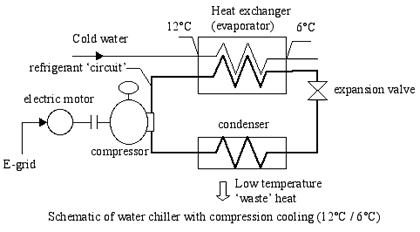Most (95 - 98%) of the cold generation for air-conditioning of buildings is done by (electric driven) compression cooling machines. Besides there are heat driven absorption cooling machines. Also sometimes heat pumps - mainly used for the generation of heat - are used for the generation of cold.
Water chiller with compression cooling
The most occurring form of cold generation for the air-conditioning of buildings takes place with a so-called water chiller. Normally this is an electrical driven compression cooling machine that delivers cold water.
The compressor is one of the six essential parts of the compression-cooling machine. The others include the condenser, evaporator, and expansion device. The compressor circulates refrigerant through the system in a continuous cycle. From the evaporator the refrigerant vapor is sucked on and brought to a higher pressure by compression. Then the refrigerant vapor is transported to the condenser where it condenses into liquid and whereby heat is given of. After that, in the expansion device a reduction in pressure takes place, whereafter the liquid at this lower pressure evaporates in the evaporator. Herewith heat is withdrawn from water (water chiller) or air (DX-system), or in other words cold is generated.
The coefficient of performance (COP) of a cooling machine is the capacity [W] (the rate of heat removal by the refrigerant) divided by the input power to the motor [W]. So cooling machines with a higher COP are more efficient, than cooling machines with a lower COP. COP’s and capacity ranges are:
- Reciprocating compressors COP = 2,0 - 4,7 Cooling capacity 10 - 500 [kW]
- Screw compressors COP = 2,0 - 7,0 Cooling capacity 300 - 2.000 [kW]
- Centrifugal compressors COP = 4,0 - 8,0 Cooling capacity 300 - 30.000 [kW]
